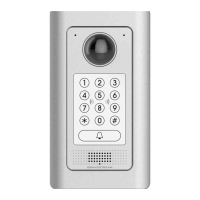GDS3710 User Manual
Version 1.0.7.8
Specifies the mechanism to transmit DTMF digits. There are 2 supported
modes:
• RFC2833 sends DTMF with RTP packet. Users can check the RTP
packet to see the DTMFs sent as well as the number pressed.
• SIP INFO uses SIP INFO to carry DTMF. Default setting is
"RFC2833"
Configures the payload type for DTMF using RFC2833.
Default value is 101.
Range: 96~127.
Allows the SIP user's registration information to be cleared when the GDS
reboots. The SIP REGISTER message will contain “Expires: 0” to unbind
the connection.
This parameter configures whether the NAT traversal mechanism is
activated. Users could select the mechanism from No, STUN, Keep-alive,
UPnP, Auto. The default setting is “No”.
If set to “STUN” and STUN server is configured, the GDS will route
according to the STUN server. If NAT type is Full Cone, Restricted Cone or
Port-Restricted Cone, the unit will try to use public IP addresses and port
number in all the SIP&SDP messages.
The GDS will send empty SDP packet to the SIP server periodically to keep
the NAT port open if it is configured to be “Keep-alive”. Configure this to be
“No” if an outbound proxy is used. “STUN” cannot be used if the detected
NAT is symmetric NAT. If the firewall and the SIP device behind the firewall
are both able to use UPNP, it can be set to “UPNP”. Both parties will
negotiate to use which port to allow SIP through.
Enable SRTP mode based on your selection from the drop-down menu.
The default setting is “Disabled”, the two other modes are “Enabled but Not
Forced” and “Enabled and Forced”.
Configures GDS settings to meet different vendors’ server requirements.
Users can choose from Standard, Broadsoft or Telefonica Spain.
The default setting is “Standard”.
In route: outbound proxy FQDN is placed in route header. This is used for
the SIP Extension to notify the SIP server that the device is behind a
NAT/Firewall.
Always sent to: SIP messages will always be sent to Outbound proxy.
Not in route: remove the Route header from SIP requests.

